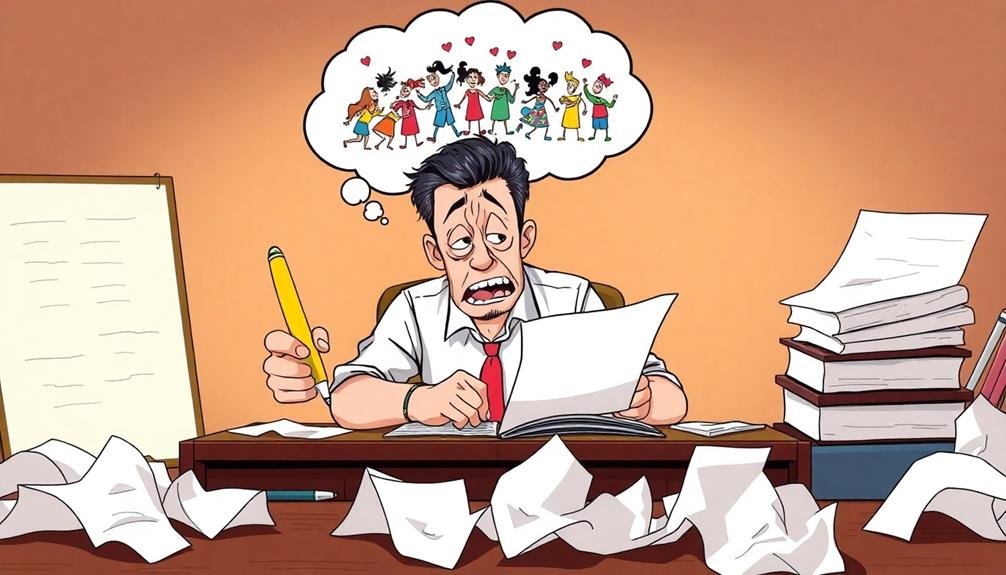To express yourself as an anxious writer, try incorporating character self-talk techniques like inner thoughts and stream of consciousness. Use subtext in dialogue to reveal hidden emotions and create tension subtly. Employ nonverbal cues and silence to convey unspoken feelings. Balance internal monologue with external dialogue for depth. Vary dialogue tags and beats to maintain engagement. Incorporate indirect communication strategies like hedging language and abrupt subject changes. When writing anxious characters, research common symptoms and reflect scattered thought patterns. These techniques can help you authentically portray anxiety and emotions in your writing. Exploring further will reveal even more powerful ways to bring your characters to life.
Character Self-Talk Techniques

Uncertainty often plagues anxious writers when crafting character dialogue. To overcome this, you can employ character self-talk techniques to enhance your dialogue writing.
Start by exploring your character's inner thoughts and emotions. Have them question their actions, reflect on past experiences, or ponder future consequences. This internal dialogue can reveal much about their personality and motivations.
Use stream of consciousness to capture your character's unfiltered thoughts. Let their mind wander, jumping from one idea to another, mimicking natural thought patterns. This technique can create a sense of authenticity and intimacy with the reader.
Incorporate rhetorical questions in your character's self-talk. These can highlight their doubts, fears, or desires, adding depth to their personality. You can also use affirmations or self-encouragement to show your character's determination or attempts to boost their confidence.
Don't shy away from contradictions in your character's thoughts. Internal conflicts can make your dialogue more realistic and relatable.
Subtext in Dialogue
Mastering subtext in dialogue can elevate your writing and engage readers on a deeper level.
You'll find that revealing hidden emotions through unspoken words adds layers to your characters' motivations.
Revealing Hidden Emotions
While characters may say one thing, their true feelings often lurk beneath the surface. As an anxious writer, you can use dialogue to reveal these hidden emotions without explicitly stating them. Pay attention to body language, tone, and word choice to convey underlying feelings. For example, a character might claim they're fine while fidgeting nervously or speaking in a clipped tone, indicating otherwise.
Use contrasting dialogue to highlight internal conflicts. A character might verbally agree with someone while their actions or facial expressions suggest disagreement. You can also employ pauses, interruptions, or sudden changes in subject to hint at unspoken thoughts or discomfort.
Consider what your characters aren't saying. Omissions and evasions can be as telling as spoken words. Use subtext to create tension and depth in your dialogue.
Layering Character Motivations
Subtext in dialogue is a powerful tool for layering character motivations and adding depth to your writing. It allows you to convey hidden meanings, conflicting emotions, and unspoken desires beneath the surface of what characters actually say. To create effective subtext, focus on the gap between a character's words and their true intentions or feelings.
Consider these techniques to incorporate subtext:
- Use body language and actions that contradict spoken words
- Create tension through what's left unsaid
- Employ double meanings or ambiguous phrasing
When writing dialogue with subtext, think about your characters' underlying motivations, fears, and desires. What're they trying to hide or achieve? How do their words mask their true intentions? By layering these motivations into your dialogue, you'll create more complex and believable characters.
Remember that subtext doesn't have to be subtle all the time. Sometimes, it can be obvious to the reader but not to other characters in the scene. This creates dramatic irony and engages your audience on a deeper level.
Practice balancing explicit dialogue with implicit meanings to craft rich, multi-dimensional conversations that reveal character depth and drive your story forward.
Creating Tension Subtly
Creating tension subtly through subtext in dialogue is a powerful way to engage readers and keep them on the edge of their seats. You can achieve this by having characters say one thing while meaning another. Use their words to hint at underlying conflicts, secrets, or emotions without explicitly stating them. This technique allows readers to read between the lines and become more invested in the story.
To create subtle tension, focus on what's left unsaid. Have characters avoid direct answers, change subjects abruptly, or use evasive language. You can also employ contradictions between a character's words and their actions or body language. For example, a character might claim they're fine while fidgeting nervously.
Another effective method is to use loaded words or phrases that carry multiple meanings. This ambiguity can create uncertainty and raise questions in the reader's mind.
Remember to balance subtlety with clarity; you don't want your subtext to be so obscure that readers miss it entirely. Practice this technique by rewriting existing dialogue to include more subtext, gradually refining your ability to create tension without relying on overt conflict.
Nonverbal Communication Cues

In addition to spoken words, nonverbal communication cues play an essential role in dialogue. These subtle indicators can convey a character's emotions, intentions, and reactions more effectively than spoken words alone. As an anxious writer, you can use nonverbal cues to add depth to your characters and create more engaging dialogue scenes.
When crafting dialogue, consider incorporating these nonverbal elements:
- Facial expressions: A raised eyebrow, a furrowed brow, or a slight smile can speak volumes.
- Body language: Posture, gestures, and physical distance between characters can reveal their relationships and emotions.
- Tone of voice: Pitch, volume, and pace can indicate a character's mood or intentions.
To effectively use nonverbal cues, observe people in real-life situations and take note of their subtle behaviors. Practice describing these cues in your writing, focusing on specific details that convey meaning.
Remember to balance nonverbal descriptions with dialogue and action to maintain a smooth narrative flow. By incorporating these elements, you'll create more realistic and engaging conversations that help readers connect with your characters on a deeper level.
Internal Monologue vs. External Dialogue
When it comes to crafting compelling dialogue, understanding the interplay between internal monologue and external dialogue is essential. As an anxious writer, you might find yourself more comfortable with internal monologue, allowing characters to express their thoughts and feelings privately.
However, relying too heavily on this technique can lead to passive storytelling and reduced character interaction. External dialogue, on the other hand, pushes characters to vocalize their thoughts and emotions, creating dynamic interactions and revealing personality traits through speech patterns and word choice.
It's vital to strike a balance between these two techniques. Use internal monologue to provide insight into a character's hidden motivations or conflicting emotions, but don't let it overshadow the importance of spoken words.
To improve your dialogue writing, try alternating between internal and external expressions. Let your characters' thoughts inform their speech, but also allow their spoken words to contradict their inner feelings. This tension can create depth and intrigue in your writing.
Dialogue Tags and Beats

You'll find that varying your dialogue attribution styles can breathe life into your writing.
By alternating between simple tags, descriptive tags, and action beats, you'll create a more dynamic and engaging conversation flow.
Experiment with action-driven speech indicators to show characters' emotions and behaviors, giving readers a fuller picture of the scene without relying solely on dialogue.
Varying Attribution Styles
Mastering the art of varying attribution styles can greatly enhance your dialogue writing. By alternating between different ways of attributing speech to characters, you'll create a more dynamic and engaging narrative flow. This technique helps prevent repetitive patterns that can make your dialogue feel stilted or monotonous.
To vary your attribution styles effectively, consider these approaches:
- Use dialogue tags sparingly, relying on context when possible.
- Incorporate action beats to show character emotions and behaviors.
- Mix up the placement of tags and beats within dialogue.
When using dialogue tags, don't limit yourself to "said" and "asked." Experiment with more descriptive verbs that convey tone and emotion, such as "whispered," "growled," or "exclaimed."
However, be cautious not to overuse these alternatives, as they can become distracting if employed too frequently.
Action-Driven Speech Indicators
Action-driven speech indicators are powerful tools for bringing your dialogue to life. These include dialogue tags and beats, which can help you convey emotions, actions, and context without relying solely on spoken words. Dialogue tags are phrases like "he said" or "she whispered" that attribute speech to a character. Beats are brief descriptions of physical actions or gestures that accompany dialogue.
To use these effectively, vary your approach. Instead of always using "said," try more descriptive tags like "mumbled," "shouted," or "sighed" when appropriate. However, don't overuse elaborate tags; "said" is often sufficient and becomes invisible to readers.
Beats can replace tags entirely, showing character actions that imply who's speaking. For example: "John crossed his arms. 'I don't agree.'"
Combine tags and beats to create a rhythm in your dialogue. Use them to break up long speeches, indicate pauses, or emphasize certain lines. Remember, less is often more. Trust your readers to follow the conversation without constant attribution.
Pacing Conversations for Tension Relief
When it comes to pacing conversations, anxious writers often struggle with balancing tension and relief. You can master this skill by understanding the ebb and flow of dialogue. Start by identifying the emotional high points in your scene and strategically place moments of respite between them.
To create tension relief, you'll want to:
- Vary sentence length and structure
- Introduce lighter topics or humor
- Allow characters to pause or reflect
Remember, not every line of dialogue needs to push the plot forward. Sometimes, characters need to catch their breath, just like your readers. You can use these moments to reveal subtle character traits or provide necessary exposition.
Don't be afraid to let silence speak volumes. A well-placed beat or a character's hesitation can be just as powerful as a lengthy monologue. By alternating between intense exchanges and calmer moments, you'll create a rhythm that keeps readers engaged without overwhelming them.
Practice pacing by reading your dialogue aloud. This will help you identify natural pauses and opportunities for tension relief, making your conversations feel more authentic and less anxiety-inducing for both you and your characters.
Humor as Anxiety Coping Mechanism

Humor can be a powerful tool for anxious writers struggling with dialogue. It allows you to inject levity into tense scenes, providing both characters and readers with much-needed relief.
When crafting humorous exchanges, focus on your characters' unique personalities and quirks. Use witty banter, sarcasm, or self-deprecating jokes to showcase their individuality and diffuse anxiety-inducing situations.
Don't be afraid to incorporate comedic timing into your dialogue. Unexpected pauses, interruptions, or misunderstandings can create laugh-out-loud moments that break tension.
Remember, humor doesn't always have to be laugh-out-loud funny; subtle, dry wit can be equally effective in easing anxiety.
Use humor to reveal character flaws or insecurities, making your protagonists more relatable and human. This technique can help anxious writers connect with their characters on a deeper level.
Additionally, employing humor in dialogue can make difficult topics more approachable, allowing you to address sensitive issues without overwhelming your readers or yourself.
Lastly, don't force humor if it doesn't fit the scene or character. Natural, organic humor will always be more effective in managing anxiety and enhancing your dialogue.
Metaphors in Character Conversations
Metaphors can breathe life into your dialogue, offering anxious writers a creative outlet for character expression. By using figurative language, you're able to convey complex emotions and ideas without relying on direct statements. This technique allows your characters to speak in unique ways, reflecting their personalities and backgrounds.
When crafting metaphors for dialogue, consider your character's perspective and experiences. A sailor might describe a difficult situation as "navigating through stormy seas," while a chef could say they're "in a pressure cooker." These comparisons add depth and authenticity to your characters' voices.
Metaphors also help you show rather than tell, engaging readers more effectively. Instead of stating a character is stressed, have them say, "My mind's a tangled ball of yarn." This approach creates vivid imagery and emotional resonance.
To effectively use metaphors in dialogue:
- Keep them consistent with the character's background
- Avoid clichés and overused comparisons
- Use them sparingly for maximum impact
Silence and Pauses in Dialogue

You'll find that silence in dialogue can be as powerful as words themselves.
By using ellipses, incorporating nonverbal cues, and leaving things unsaid, you can create tension and depth in your characters' conversations.
These techniques allow your readers to fill in the gaps, making the dialogue more engaging and realistic.
Effective Use of Ellipses
When crafting dialogue, ellipses serve as powerful tools to convey pauses, hesitation, and unspoken thoughts. As an anxious writer, you can use ellipses to express uncertainty or reluctance in your characters' speech. They're particularly effective in moments of tension or emotional vulnerability.
To use ellipses effectively, consider the following:
- Place them at the beginning or end of a sentence to indicate trailing off
- Insert them mid-sentence to show a pause or change in thought
- Use them sparingly to avoid overreliance and maintain impact
Remember, ellipses aren't just for indicating omitted words. They can create rhythm in your dialogue, mimicking natural speech patterns. You can use them to build suspense, show a character struggling to find the right words, or imply something left unsaid.
Be cautious not to overuse ellipses, as they can become distracting. Instead, vary your punctuation and dialogue techniques to keep your writing dynamic.
When used judiciously, ellipses can add depth to your characters' conversations and help readers connect with their emotions and thought processes.
Nonverbal Cues in Text
Beyond spoken words, dialogue comes alive through nonverbal cues. In text, you can convey silence and pauses to add depth to your characters' interactions. Use em dashes to show interruptions or sudden shifts in thought. For example: "I don't think—" she paused, reconsidering her words.
Ellipses can indicate trailing off or hesitation: "I'm not sure…" he mumbled, avoiding eye contact.
Describe physical actions to show a character's emotional state. "She wrung her hands as she spoke" suggests anxiety, while "He leaned back, crossing his arms" implies defensiveness.
Facial expressions and body language can speak volumes: "His eyebrows furrowed, lips pressed into a thin line" conveys frustration without explicitly stating it.
Don't forget about the environment. Sounds, like a ticking clock or distant thunder, can heighten tension. Even the absence of sound can be powerful: "The room fell silent, their unspoken words hanging heavy in the air."
Tension Through Unspoken Words
Silence and pauses in dialogue can be powerful tools for creating tension and revealing unspoken truths. When you're writing, remember that what's left unsaid often speaks volumes.
Use strategic pauses to heighten the emotional impact of a scene or to emphasize a character's internal struggle.
To effectively incorporate silence in your dialogue:
- Allow characters to trail off mid-sentence
- Insert beats or actions between lines of dialogue
- Use ellipses (…) to indicate hesitation or unfinished thoughts
These techniques can convey a character's reluctance, uncertainty, or inner conflict without explicitly stating it.
You can also use silence to build suspense or create awkward moments between characters. Pay attention to the rhythm of your dialogue and don't be afraid to let silence linger.
Indirect Communication Strategies
Indirect communication strategies often play an essential role in crafting realistic dialogue for anxious characters. You can use these techniques to show how your characters struggle to express themselves directly, mirroring real-life interactions of those with anxiety.
Consider employing hedging language, where characters use phrases like "maybe," "I think," or "possibly" to soften their statements. This reflects uncertainty and a fear of committing to definitive opinions. You can also use qualifiers such as "kind of" or "sort of" to downplay the intensity of emotions or ideas.
Another effective strategy is having characters change subjects abruptly or trail off mid-sentence. This shows their discomfort with certain topics or difficulty in maintaining focused conversations. You might also incorporate non-verbal cues, like describing a character's body language or tone of voice, to convey hidden meanings behind their words.
Lastly, explore the use of euphemisms or vague language. Anxious characters may avoid direct terms, instead opting for less confrontational or emotionally charged alternatives. This indirect approach can add depth to your dialogue, revealing your characters' inner struggles without explicitly stating them.
Emotional Projection Through Dialogue

Emotional projection through dialogue offers a powerful tool for anxious writers to convey their characters' inner turmoil. By carefully crafting conversations, you can reveal a character's emotional state without explicitly stating it. This technique allows you to show rather than tell, creating a more immersive experience for your readers.
To effectively project emotions through dialogue, focus on the following elements:
- Word choice: Select vocabulary that reflects the character's mood and mindset.
- Sentence structure: Use short, choppy sentences for anger or longer, rambling ones for nervousness.
- Subtext: Incorporate hidden meanings beneath the surface of the conversation.
You can also use dialogue tags and actions to reinforce the emotional tone. For example, a character might "snap" or "mutter" their words, or fidget while speaking. These subtle cues help paint a vivid picture of the character's emotional state.
Writing Authentic Anxious Characters
While emotional projection through dialogue can reveal a character's inner world, creating authentic anxious characters requires a deeper understanding of anxiety itself. To write convincing anxious characters, you'll need to explore the physical and mental manifestations of anxiety.
Start by researching common symptoms like racing thoughts, rapid heartbeat, and sweating. Incorporate these into your character's internal monologue and physical reactions. Use short, choppy sentences to mimic the scattered thought patterns of an anxious mind. Employ repetition to emphasize obsessive thinking.
Show your character's anxiety through their speech patterns. They might stutter, trail off mid-sentence, or frequently use filler words. Don't forget to include avoidance behaviors, such as making excuses to skip social events or overthinking simple decisions.
Balance your character's anxious moments with periods of calm to create a more realistic portrayal. Remember that anxiety isn't a constant state but can be triggered by specific situations or thoughts.
Frequently Asked Questions
How Can Anxious Writers Overcome Writer's Block When Crafting Dialogue?
To overcome writer's block for dialogue, you can try freewriting conversations, eavesdropping on real-life discussions, or acting out scenes. Don't overthink it—jot down natural-sounding exchanges and refine them later. Practice regularly to build confidence.
What Software Tools Can Assist Anxious Writers in Developing Realistic Dialogue?
You'll find several helpful tools for dialogue development. Try Scrivener for organizing character conversations, WriterDuet for collaborative scripting, or Dramatica for story structure. Voice-to-text apps can also capture natural speech patterns you'd use in real conversations.
Are There Specific Exercises to Practice Writing Dialogue for Anxious Characters?
You can try role-playing exercises, writing monologues from an anxious character's perspective, or creating dialogue scenarios that explore common anxiety triggers. Practice pausing dialogue with physical cues and internal thoughts to convey nervousness and hesitation.
How Can Anxious Writers Effectively Collaborate on Dialogue With Writing Partners?
You can effectively collaborate by setting clear boundaries, using shared documents for real-time edits, and scheduling regular check-ins. Don't hesitate to voice your concerns, and take breaks when needed. Trust your partner's input and feedback.
What Role Does Cultural Background Play in Writing Dialogue for Anxious Characters?
Your character's cultural background shapes their anxiety expression in dialogue. You'll need to contemplate their upbringing, traditions, and social norms. It'll influence their word choice, body language, and how they communicate emotional distress.
In Summary
You've now explored various dialogue techniques to help anxious writers express themselves more effectively. By incorporating these methods into your writing, you'll create more authentic, nuanced characters and conversations. Remember, it's okay to feel anxious about your writing. Use these tools to channel that anxiety into your characters' voices. Keep practicing, and you'll find your own unique way of bringing anxious characters to life through dialogue. Trust your instincts and let your characters speak.





Leave a Reply